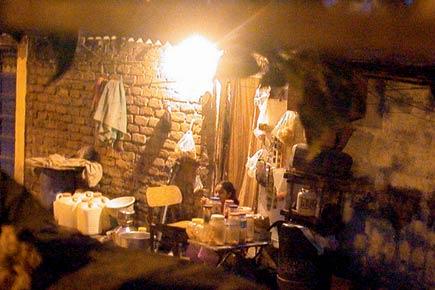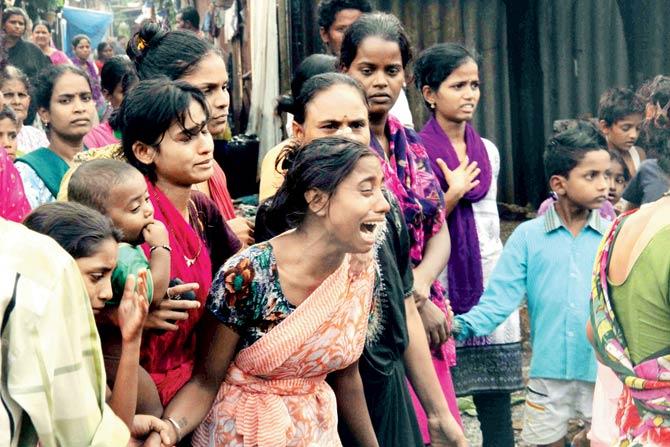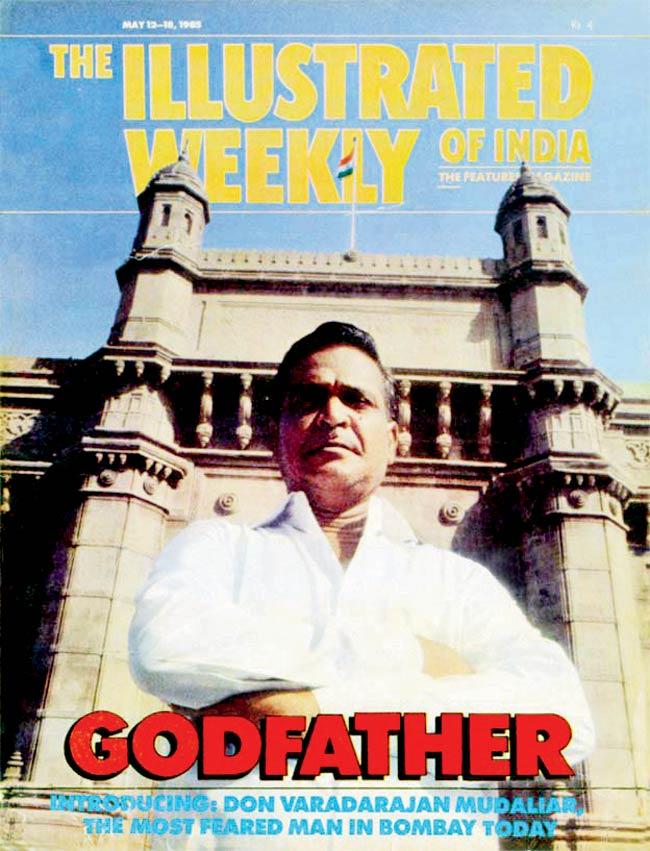Mangroves, creeks and a large daily-wage population tips Mumbai’s scales against the illegal liquor mafia. In the wake of the Malvani hooch tragedy we trace how this nexus has been operating in the city

The first reports of hospitalisation and deaths at Kharodi village on June 18 started trooping into Malvani police station at around 10.15 am.
Mumbai hooch tragedy: List of officials who let 106 people die grows longer
ADVERTISEMENT

A December 29, 2004, picture of an illegal liquor den in the slums behind Rajawadi Hospital. That month, 87 people in Vikhroli died after consuming spurious liquor
Over 130 residents of the predominantly East Indian village were reporting loss of vision, vomiting and kidney failure. Soon, it was reported that all those who had been rushed to Shatabdi Hospital had, the previous night, bought spurious liquor from local dens.

Relatives mourning victims of the Malwani tragedy
The death toll, which was nine on Wednesday, crossed 100 on Monday night - turning out to be one of Mumbai’s worst hooch tragedies in a decade. In December 2004, 87 people lost their lives after consuming spurious liquor from local bars in Vikhroli, officials from the state excise department say.
Mumbai hooch tragedy: Excise official helped methanol mafia for Rs 10-cut on each litre?

The May 1985 cover of The Illustrated Weekly, a Times of India publication, with liquor mafia don Vardharajan Mudaliar on its cover
As investigations into the Malvani tragedy continued, it emerged that the victims - 104 have died and 34 people are still receiving treatment - had consumed liquor lined with high doses of methanol.
Within a week, investigations by the Mumbai Crime Branch, revealed a larger nexus: a mafia rooted in Vapi (in Gujarat), 125 km from Mumbai, was found to be supplying ethanol and methanol to Mumbai’s liquor mafias who would then supply them to local bootleggers.
City police estimate that currently there are 60 such small groups in the city, which brew their illicit liquor in the thick of the mangroves along Goregaon, Malad, Malvani, the wooded areas of the Sanjay Gandhi National Park - making police penetration difficult.
While nine have been arrested in the last fortnight in this case - including Atiq Latif Khan (who was a liquor supplier in Malvani) along with Kishore Patel from Vapi (who supplied methanol to Khan) - this is just the tip of the iceberg.
On June 16 Khan, says ACP Sunil Deshmukh of the Crime Branch, had run out of ethanol - a sweet byproduct of sugar manufacturing which is the alcohol content of every liquor drink - and contacted Patel, a new supplier.
However, what he got was methanol - also a byproduct of the sugar manufacturing process, but lethal if it makes up more than three per cent of the alcoholic drink.
“Methanol and ethanol add a ‘kick’ to the liquor which ensures that consumers return to the same liquor den,” a Crime Branch official said not wishing to be named. Between June 6 and July 2 the excise department conducted several raids across the state, registering cases against 2,876 people and arrested 1,139.
While its largest haul of illicit liquor and raw material, worth Rs 1.99 crore, was recovered from Kolhapur, the Mumbai-Thane belt came close second with a haul of Rs 1.77 crore. Most brewing units, say state excise department officials, set up shop near sources of water, which makes Mumbai, with its creeks and rivers, an ideal location. Its burgeoning slums mean that consumers are easy to find.
A state excise department official, requesting anonymity, said, “Mumbai and Thane have a high population of daily wage labourers, who cannot afford country liquor and, therefore, depended on hooch which at Rs 12 per litre is much cheaper.”
Poison from Vapi
The state excise department has conducted 117 raids across the city on illegal liquor manufacturing units in the last 18 months alone. Of these, 21 were in Kharodi village. Yet, cops will tell you that there is little control that they can exercise over the entry of methanol into the market. It’s the responsibility of excise officials, they say.
The ethanol from factories - Vapi is a sugar manufacturing hub - is divided into usage for liquor manufacturing and for non-consumption purposes. Its suppliers have to keep the local excise department updated about the quantities produced. Once they send their consignments to legal alcohol manufacturing units, they are expected to add butanol to the liquid -which makes it extremely bitter.
This mix, says Deshmukh, is used in making perfumes, preparations for essence and flavouring, pharmaceuticals. It is also added to lubricant oils. However, Deshmukh alleges that they have often found that excise department officials, in connivance with the suppliers, do not comply with the butanol rule. Excess ethanol is then illegally supplied to Gujarat and Mumbai.
But, ethanol isn’t the problem here. Methanol is not meant for human consumption. It is mainly used in making plastics, synthetic fibers, paints, carpeting, refrigerants and pigment for dyes. Excess consumption of can lead to kidney failure and loss of vision.
Produced in sugar factories in Vapi, methanol and ethanol are smuggled out by local road transporters and sold in the black market. Every morning, several drums containing these are smuggled into Mumbai, with the collusion of octroi officials - under the scanner, post the June 17 tragedy, they are not talking to the media. Once in the city, the chemicals are supplied to liquor den owners who add it to their mixtures and sell it to their customers.
Most low-quality liquor is brewed from black jaggery, navsagar or yeast, peels of citrus fruits like oranges and sweet lime. These are mixed with water and kept for a few days in a barrel, which is submerged in water for fermentation. Once that is completed, the vessel, to which some ‘masala’ is added, is put on a wood-fired ‘bhatti’ and hooch is collected through condensation.
Vardharajan’s hooch empire
In his book Dongri to Dubai: Six Decades of Mumbai Mafia, published by Roli Books, Hussain Zaidi, writes that the illicit liquor trade first gained prominence in the state when Morarji Desai imposed prohibition in 1952.
This is when Vardharajan Mudaliar, who had links with Haji Mastan, set up a den at Antop Hill, Central Bombay. Dharavi, Sion, Koliwada, and Antop Hill - with their dense hutments - proved a great advantage.
“The area was dotted with small huts where local liquor was illicitly manufactured. With help of a local network and bribes to the police, the trade made way to bars in Bombay. Vardharajan started gaining entry into the trade when it was still in its early days.
“People started pouring into the city in groups, especially from southern India-Karnataka, Tamil Nadu, Andhra Pradesh, Kerala-and with each day the slums lined across the central region began to grow.
It would not be an exaggeration to say that Vardharajan, in a small way, had much to do in making Dharavi the biggest slum space in Asia. The reports during the sixties peg his trade of illicit liquor to around Rs 12 crore a year,” writes Zaidi.
The crackdown
In June 1982, the then Mumbai police commissioner Julio F Ribeiro brought in DCP YC Pawar, who had, in the late ‘70s broken the illicit liquor trade in Nashik, to police the high pressure Dharavi Zone.
The liquor trade had catapulted Vardharajan’s power in the city. With the increased hooch income, he and his men had become a law and order problem, getting involved in murders, land grabbing and being accused of rapes.
Mumbai hooch tragedy: Dealer ran out of ethanol, used methanol
“When I took charge, the entire belt of mangroves was occupied by the liquor mafia,” recalls Pawar, whose jurisdiction extended from Dadar to Trombay, covering Mahim, Matunga and Dharavi.
“There were nearly 300 liquor units operating in Mumbai alone and most of these were concentrated in the creeks of Antop Hill and Ravili Creek near Sion Koliwada. In the Trombay and Vashi creeks they used lepers to make spurious liquor,” he adds.
Pawar, who retired in 2001 as Mumbai’s Joint Commissioner of Police, Law and Order, now runs a legal consultancy firm at Matunga. He tells us that the dens would together manufacture 60,000 litres daily. The liquid was filled in tubes of truck tyres which were piled up on the deserted roads of Dharavi and taken over by “wheelmen” or distributors.
These were transported in gunny-bags or placed in car trunks. Pawar nurtured some of Vardhabhai’s men as informers and gradually began a major crackdown by entering his liquor dens and destroying them.
After a series of such raids, Pawar gave a first big jolt to Vardharajan when he laid his hands on his right hand man Khaja bhai after a particularly intense car chase on July 28, 1982, in which his driver was injured when one of the mafia men hurled a stone at their car.
The man who hurled the stone turned out to be Khaja’s manager. Later, cops picked up Khaja too. Vardharajan tried to use clout to ease the pressure on his gang. But by then, the police had already busted his network. Wihtin weeks, income from illicit liquor dens and slums disappeared and Vardharajan fled to Thoothukudi in Tamil Nadu.

However, with the Mumbai police still hot on his heels, he surrendered on January 5, 1987. The courts acquitted him for lack of evidence and, on January 2, 1990, he passed away in Chennai.
Mumbai hooch tragedy: 1 held, 2 detained, and another 'Daddy' surfaces
Life came to a standstill in Dharavi, Matunga and Sion Koliwada when his body was flown into the city. “Though we managed to crack the backbone of the liquor racket in the city, it broke down the trade in smaller factions, these continue to operate in Mumbai,” rues Pawar.
- With inputs from Ranjeet Jadhav
 Subscribe today by clicking the link and stay updated with the latest news!" Click here!
Subscribe today by clicking the link and stay updated with the latest news!" Click here!







